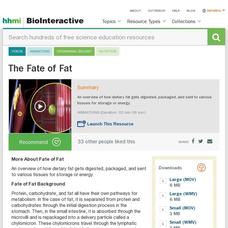Howard Hughes Medical Institute
Body Mass Index (BMI)
Know your number! Diabetes and heart disease both increase with higher body mass index numbers. Understanding the body mass index (BMI) helps scholars take control of their own health. They view a comparison of what various BMI...
Howard Hughes Medical Institute
The Fate of Fat
Humans need fat for energy and nutrition, but how much is too much? A short animation shows the pathway of fat as it enters the body, breaks down through digestion, and travels for use or storage. Teaching tips offer multiple ways to...
SciShow
The Deal with Fat
Fats are essential to a balanced diet and help bodies use certain vitamins as well as maintain healthy skin and hair. While watching the video, learners explore fat, which is certainly talked about a lot in terms of health. The narrator...
Howard Hughes Medical Institute
PPAR-gamma Activation in the Fat Cell
Each human contains more than six times the number of fat cells than there are people on the planet. Scholars learn how fat cells work to absorb fat and release hormones through a short animation. They recognize the relationship between...
American Chemical Society
The Cold Truth About Fat
Our bodies store two types of fat: brown fat and white fat—and brown fats are actually efficient at burning calories! An episode of the ACS Reaction series compares exercise generating brown fat to shivering cold. It turns out 15 minutes...
Bite Sci-zed
Saturated vs. Unsaturated Fats
What are good fats and bad fats? Learn about the structure and function of lipids and how that relates to carbon bonding. Scholars explore the structural differences between saturated and unsaturated fats and examine relevant examples...
Bozeman Science
Anatomy and Physiology Introduction
Muscle tissue is three times more efficient at burning calories than fat. Here is a video that explores how form fits function, introducing anatomy and physiology. The instructor then explores homeostasis, hierarchy associated with...
Crash Course
Alkenes and Alkynes
What is the difference in alkanes, alkenes, and alkynes? How can you remember which is which? Viewers learn about naming rules, cis-trans isomerism, hydrogenation, halogenation, polymerization, and triglycerides from a short video that...
Howard Hughes Medical Institute
Leptin Feedback Control System
Hormones come from many parts of the body, including the hormone leptin produced by fat tissues. This in turn, controls each person's hunger levels. Interested nutritionists view the feedback loop relating food intake, hormone levels,...
TED-Ed
How Does Hibernation Work?
Did you know animals hibernate all around the world, even in the deserts and tropical rain forests? How do these animals reach extreme body temperatures and undergo a decreased heart rate that would be deadly to non-hibernating animals?...
SciShow
Weight Loss Pills: Fact Or Fiction?
Most over-the-counter weight loss pills have not been tested or even approved by the FDA. Learners see the truth behind weight loss pills and why many claims are false. The narrator begins by exploring prescription diet pills—fat...
Howard Hughes Medical Institute
How We Get Our Skin Color Interactive
I can see your epidermis. A short video shows how we get our skin color. It explains how melanocyte cells in the epidermis produce melanin, and that the type and amount of melanin controls skin color.
Crash Course
Digestive System (Part 1)
The stomach can hold 1.5 liters of food, which remains there for two to three hours in order for digestion to complete. The 33rd video in a series of 47 covers the process of digestion. Classes learn why digestion occurs, about the...
MinuteEarth
What is Skin For?
Smooth or scaly, skin is sensational! Besides keeping us from being gooey, what does it do? Pupils embark on an integumentary investigation with a short video about skin. Topics include the special features of skin cells, how skin...
Other popular searches
- Body Fat Analysis
- Body Fat Percentage and Bmi
- Testing Your Body Fat
- Body Fat Percentage and Bm
- Decrease Body Fat
- Body Fat Percentage
- Physiology Body Fat
- Body Fat Index















